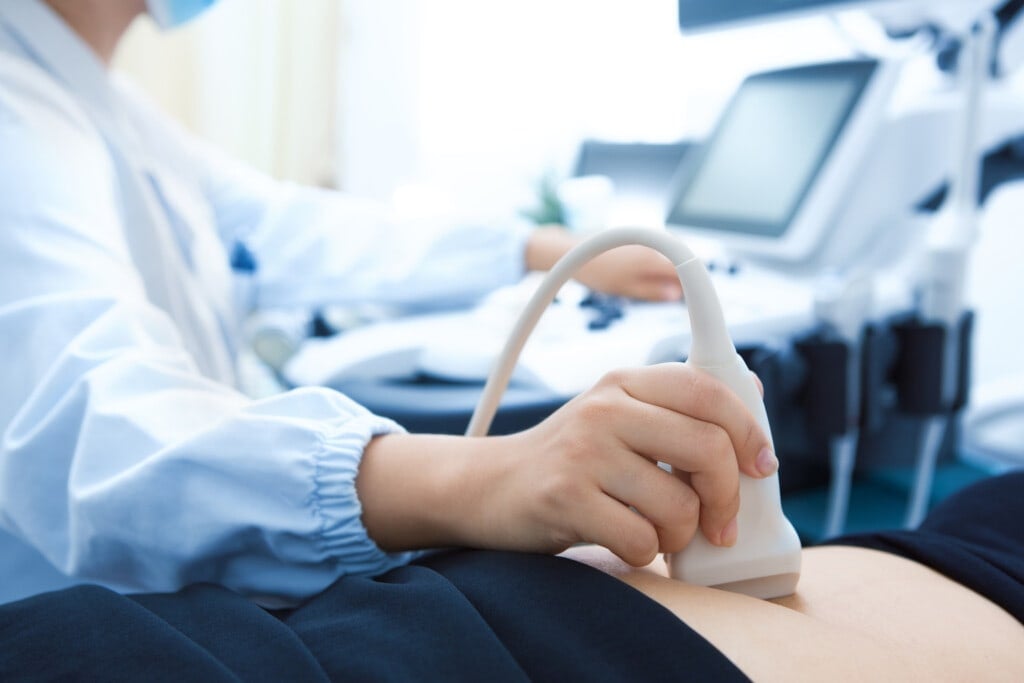Wow, you’re already eight weeks into your pregnancy. Time is sure flying! While there are still about 32 more weeks to go until you can meet your little one, you can relish in the joys and wonders of what your baby will look like. Special facial features are starting to develop at this stage, like tiny eyelids, an adorable pucker of an upper lip, and the small tip of a button nose.
To ensure your love bug is growing smoothly and to rule out any abnormalities, your gynecologist will likely recommend a first trimester ultrasound during this timeframe. However, it is possible that your initial prenatal appointment may not happen till the 10- to 12-weeks pregnant marker.
If you’re feeling anxious, we’re here to help calm those nerves by sharing the ins and outs of your first ultrasound. You’ll be armed with reassuring information, so you can go back to focusing on who your bundle of joy will end up looking like. (We vote mom!)
What is an ultrasound?
An ultrasound is a safe medical imaging test that uses high-frequency sound waves to produce images (also known as a sonogram) of the inside of your body, such as your internal organs and tissues.1 Two types of ultrasounds can be used during a prenatal appointment: transvaginal and transabdominal.
Transvaginal
Most commonly used early in a pregnancy, transvaginal ultrasounds occur by placing a wandlike device (or transducer) inside the vagina. The transducer then releases sound waves that capture images of your cervix, fallopian tubes, ovaries, uterus, and pelvic region. This test can verify a pregnancy. It can also monitor your baby’s heartbeat and determine if there are any issues.
Transabdominal
A transabdominal ultrasound is what most people initially envision when they hear the word “ultrasound.” It is a handheld device passed back and forth through gel slathered over a woman’s abdomen. During this process, the transducer will emit sound waves across the belly and bounce off the baby’s bones and tissues to showcase a picture of them. This allows mamas-to-be to see their little one on the screen.
Why am I getting an 8 week ultrasound?
Not all pregnancies are the same. Not all women are the same. With that comes different experiences. The noninvasive test allows healthcare professionals to examine not only your health but also your baby’s at this point. It also helps your doctor check in on the status of the typical development process.
Additional reasons include:
Gestational Age
Are you counting down the days until you can meet your newborn face-to-face? Your physician can give you a more accurate date of your angel’s big debut through your ultrasound by measuring the gestational age of your pregnancy (a.k.a. how far along you are).
Multiple Pregnancies
It’s all in the name with this one. Your physician will check for the number of fetuses in your womb, with the most common type of multiple pregnancies being twins. Rarely are there three or more fetuses in a single pregnancy. So don’t freak out just yet!
Heartbeat
Nothing in the world will sound more magnificent than hearing your baby’s heartbeat for the very first time. During your ultrasound, you should be able to hear the beautiful thudding. A fetus’s heartbeat is typically detectable around six weeks of gestation and beats between 150 and 160 beats per minute.2
Ectopic Pregnancy
If you’re experiencing pelvic or abdominal pain or vaginal bleeding, your doctor will perform a pelvic ultrasound to rule out an ectopic pregnancy. This occurs when a fertilized egg has implanted outside the uterus, such as in the fallopian tubes, which is the most common location where it may occur. Other areas can include the cervix, cesarean scars, abdomen, or pelvis.
If you’re not feeling any pain, it’s still vital that your embryo’s location is confirmed. Although ectopic pregnancies are rare, occurring in about 1.4 percent of pregnancies, they can cause organ damage and are life-threatening if untreated.3
How can I prepare for an ultrasound?
For a transvaginal ultrasound, little to no preparation is needed. During your appointment, you’ll be asked to remove your clothing and any jewelry that can interfere with the test while in the examination room and be given a gown to put on. You’ll likely be asked to use the restroom to empty your bladder before the ultrasound.
On the other hand, your physician will request you have a full bladder for the examination during a transabdominal ultrasound. You’ll need to consume about 32 ounces of water an hour before the test since a full bladder helps lift the intestines to provide a clearer image of your organs. You can use the bathroom after your ultrasound if needed.
In comparison to the transvaginal test, you will not be required to wear a gown. Wear comfortable clothing that day, like a loose shirt that you can easily lift to your chest when the cooling gel is placed on your belly.
What happens after the ultrasound?
If your physician performs the ultrasound, you may receive your results sooner. If a technician conducts the test, the images are saved and passed to a radiologist. The radiologist will then analyze the scans and send a report to your healthcare provider. The examination takes about a half-hour. But the results may not be ready for 24 hours.
Keep in mind that there are no risks in getting an ultrasound. And the test results can help ease any worries you may have. This is an exciting moment in your pregnancy, so be sure to relish this small sneak peek of your baby!




































